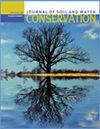青藏高原东北部青海湖流域高寒草甸季节性冻融过程中土壤大孔和根系构型特征及其对输水的影响
IF 2.6
4区 农林科学
Q2 ECOLOGY
引用次数: 0
摘要
低温、冻融循环和短生长季节是高山土壤的特征。高山生态系统中广泛分布着具有密集根系网络的特殊诊断层——基质表层层。青藏高原基质表层土壤大孔和根系对季节性冻融过程的响应研究较少。利用x射线计算机断层扫描技术对季节性冻融过程中高寒草甸土壤大孔隙和根系进行了表征,揭示了土壤大孔隙和根系结构对高寒草甸基质表层水分运移的影响。结果表明:在不稳定冻结阶段和不稳定融化阶段,土壤孔隙分布较为均匀,而在完全融化阶段和完全冻结阶段,存在明显的基质表层层;TP阶段土壤的总表面积密度(0.1898 mm2 mm−3)、长度密度(225.28 mm mm−3)、节点密度(1592个节点)均较高。mm−3),土壤大孔连通性(0.3144)高于UFP、UTP和FP阶段。在TP阶段,根系密度、表面积密度、分枝密度、长度密度和节点密度与土壤大孔隙度、表面积密度、长度密度、节点密度和弯曲度呈显著相关。在FP阶段,根系与土壤大孔特征之间不存在相关性。垂直水在TP阶段比在UFP和UTP阶段更容易通过基质表层。根系是高寒草甸土壤水分运移的优先通道。因此,基质表层是青藏高原水分和养分储存的关键层,根系发育程度较高,在青藏高原的持水功能中起着重要作用。本文章由计算机程序翻译,如有差异,请以英文原文为准。
Characteristics of the soil macropore and root architecture of alpine meadows during the seasonal freezing-thawing process and their impact on water transport in the Qinghai Lake watershed, northeastern Qinghai–Tibet Plateau
Low temperatures, freezing-thawing cycles, and short growing seasons characterize alpine soils. The mattic epipedon, a special diagnostic surface horizon with an intensive root network, is widely distributed in alpine ecosystems. Studies on the soil macropores and roots of the mattic epipedon layer in response to seasonal freezing-thawing processes on the Qinghai–Tibet Plateau are lacking. This study characterized the soil macropores and roots of alpine meadows during the seasonal freezing-thawing process using X-ray computed tomography and revealed the influence of soil macropores and roots structure on water transport in the mattic epipedon layer of the alpine meadows. The results showed that the soil pore distribution was more uniform during the unstable freezing stage (UFP) and the unstable thawing stage (UTP), whereas there was a clear mattic epipedon layer during the completely thawed stage (TP) and the completely frozen stage (FP). Soils in the TP stage had a higher total surface area density (0.1898 mm2 mm−3), length density (225.28 mm mm−3), node density (1,592 no. mm−3), and connectivity (0.3144) of soil macropores than those in the UFP, UTP, and FP stages. In the TP stages, the density, surface area density, branch density, length density, and node density of roots had significant correlations with the macroporosity, surface area density, length density, node density, and tortuosity of soil macropores. In the FP stage, there were no correlations between the root and soil macropore characteristics. Vertical water is expected to move more readily through the mattic epipedon in the TP stage than in the UFP and UTP stages. Roots were the preferential pathways for water transport into the soil layer of the alpine meadow. Therefore, the mattic epipedon is a key layer for water and nutrient storage and plays an important role in the water-holding function of the Tibetan Plateau due to its greater root development.
求助全文
通过发布文献求助,成功后即可免费获取论文全文。
去求助
来源期刊
CiteScore
4.10
自引率
2.60%
发文量
0
审稿时长
3.3 months
期刊介绍:
The Journal of Soil and Water Conservation (JSWC) is a multidisciplinary journal of natural resource conservation research, practice, policy, and perspectives. The journal has two sections: the A Section containing various departments and features, and the Research Section containing peer-reviewed research papers.

 求助内容:
求助内容: 应助结果提醒方式:
应助结果提醒方式:


